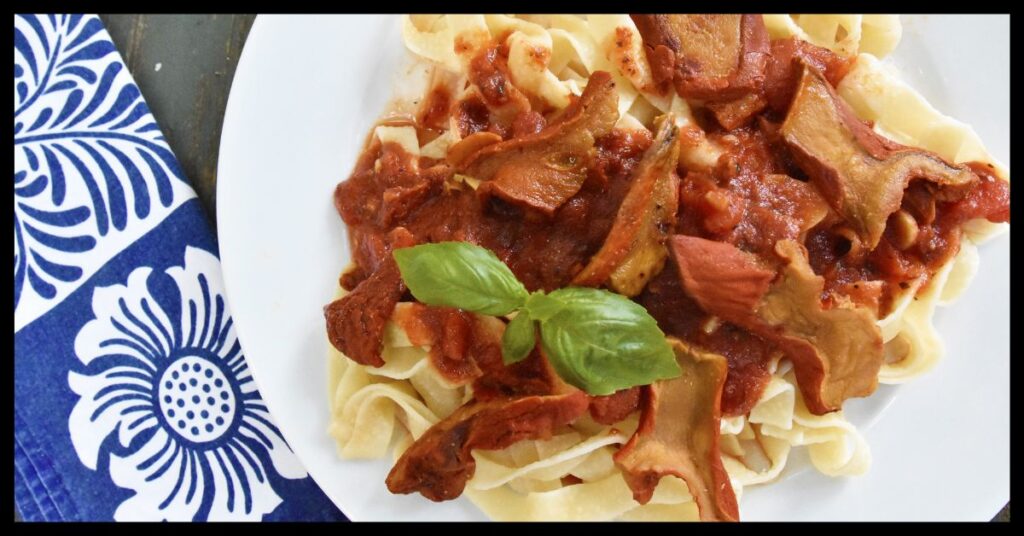Lobster mushrooms are not seafood, despite their name. Instead, they are a fascinating type of fungus that gains their distinctive color and flavor from a parasitic mold. These mushrooms are sought after for their meaty texture, vibrant orange-red hue, and rich, seafood-like taste. Whether you’re a gourmet cook or simply curious about foraged foods, this guide offers an engaging, step-by-step recipe for cooking lobster mushrooms, along with helpful information to prepare them safely and deliciously.
Table of Contents
ToggleWhat Are Lobster Mushrooms?
Lobster mushrooms (Hypomyces lactifluorum) are not technically mushrooms themselves. They are the result of a parasitic fungus (Hypomyces) infecting a host mushroom, typically from the Lactarius or Russula species. This transformation gives them a firm, dense texture and an aroma reminiscent of seafood, hence the name “lobster” mushroom.
They are commonly found in North American forests during late summer and fall. Due to their unique flavor and texture, lobster mushrooms are often used as a seafood substitute in vegetarian and vegan recipes.
Health Benefits of Lobster Mushrooms
Lobster mushrooms are not only flavorful but also nutritious. While specific nutritional data on lobster mushrooms is limited, they are generally believed to share similar health benefits with other edible wild mushrooms:
- Low in calories and fat
- Rich in dietary fiber
- Contains antioxidants like ergothioneine
- Provides essential minerals such as potassium, copper, and iron
(Source: USDA National Nutrient Database)
These nutritional properties make them a healthy addition to various dishes.
Safety Tips Before Cooking
Foraging for wild mushrooms comes with risks. Only consume lobster mushrooms if they have been correctly identified by an experienced forager or purchased from a trusted vendor. Improperly identified wild mushrooms can be toxic.
Tips:
- Discard any lobster mushrooms that have a strong fishy odor or appear slimy.
- Clean mushrooms gently with a brush or damp cloth—avoid soaking them in water.
- Always cook lobster mushrooms thoroughly to improve flavor and digestibility.

Simple Sautéed Lobster Mushroom Recipe
This easy, sautéed lobster mushroom recipe showcases their rich flavor with minimal ingredients. It serves as a perfect introduction to cooking with these unique fungi.
Ingredients:
- 1 lb fresh lobster mushrooms
- 2 tablespoons olive oil or unsalted butter
- 2 cloves garlic, minced
- 1 small shallot, finely chopped (optional)
- Salt and freshly ground black pepper to taste
- Fresh parsley, chopped (for garnish)
Instructions:
1. Clean the Mushrooms
Gently brush off any dirt using a mushroom brush or soft cloth. Avoid washing them under running water as they can absorb moisture and become rubbery. Trim any tough or discolored parts.
2. Slice the Mushrooms
Cut the mushrooms into uniform slices or bite-sized pieces. Their firm texture allows them to hold shape well during cooking.
3. Heat the Pan
In a large skillet, heat the olive oil or butter over medium heat. Once hot, add the shallots (if using) and garlic. Sauté for 1–2 minutes until fragrant.
4. Cook the Mushrooms
Add the sliced lobster mushrooms to the pan. Cook for about 8–10 minutes, stirring occasionally. The mushrooms will release some moisture initially, then start to brown and crisp around the edges.
5. Season and Serve
Season with salt and black pepper. Finish with chopped fresh parsley and serve warm as a side dish or topping for pasta, rice, or toast.
Variations and Serving Suggestions
Lobster mushrooms‘ versatility allows them to be featured in a variety of recipes beyond sautéing. Here are a few popular variations:
1. Lobster Mushroom Risotto
Add diced lobster mushrooms to a classic risotto recipe for a deep umami flavor. Their firm texture holds up well in creamy dishes.
2. Lobster Mushroom Tacos
Use sautéed mushrooms as a filling for tacos along with avocado, red cabbage, and lime crema for a vegetarian twist on seafood tacos.
3. Lobster Mushroom Pasta
Sauté mushrooms with garlic and olive oil, then toss with fettuccine or linguine. Add a splash of white wine and finish with grated Parmesan or vegan cheese.
4. Lobster Mushroom Soup
Blend lobster mushrooms into a creamy base with vegetable broth, onions, and herbs for a comforting fall soup.
Storing and Preserving Lobster Mushrooms
To store fresh lobster mushrooms:
- Refrigerate in a paper bag or loosely wrapped in a cloth to allow airflow.
- Use within 3–5 days for best quality.
To preserve them:
- Drying: Slice and dehydrate lobster mushrooms using a food dehydrator or low oven heat. Store in an airtight container for up to 6 months.
- Freezing: Sauté mushrooms first, then freeze in sealed containers or freezer bags.
Sustainability and Foraging Practices
Lobster mushrooms are foraged rather than cultivated. Sustainable foraging is essential to preserving natural ecosystems:
- Harvest responsibly: Only take what is needed and avoid damaging surrounding vegetation.
- Use a mesh bag to allow spores to disperse during foraging.
- Follow local regulations: Some areas have rules about mushroom foraging to protect endangered species or parklands.
For those who prefer not to forage, many gourmet food stores and online retailers offer dried or fresh lobster mushrooms, depending on the season.
Conclusion
Lobster mushrooms offer a rare and delightful experience in the world of wild edibles. With their unique appearance, robust texture, and seafood-like flavor, they can elevate a range of recipes—from simple sautés to gourmet risottos. Always ensure safe sourcing and proper preparation to enjoy the best of what lobster mushrooms have to offer.
Whether featured as a main ingredient or used to enhance other dishes, this versatile fungus deserves a spot in any adventurous kitchen. By following safe cooking practices and using sustainable foraging or purchasing methods, home cooks can enjoy this culinary treasure responsibly.
FAQ
Are lobster mushrooms safe to eat?
Yes, when properly identified. Always avoid mushrooms with foul odors or signs of decay.
Do lobster mushrooms taste like lobster?
They have a seafood-like flavor and aroma, making them a good substitute in seafood-style dishes.
Can lobster mushrooms be eaten raw?
No. Like most wild mushrooms, they should be cooked to enhance flavor and reduce any potential digestive issues.







